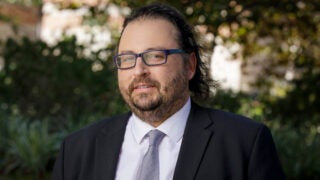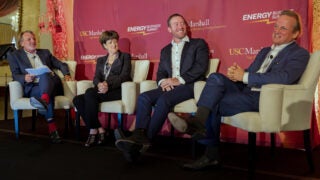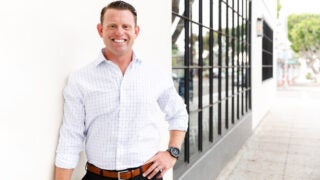Building the perfect space to spark creativity — and disruption
USC Iovine Young Academy welcomes its inaugural class of freshmen to The Garage
The USC Jimmy Iovine and Andre Young Academy for Arts, Technology and the Business of Innovation has enrolled its first class of 31 exceptional students, and on Aug. 20, the students got their first look at their new home: The Garage, a 9,000-square-foot dynamic workspace on the fourth floor of the Ronald Tutor Campus Center.
“Oh my gosh, this is amazing. It’s definitely not like any classroom I’ve been in before,” said Serene Boachie of Frisco, Texas, as she walked in the door and took in the circular layout, with fabrication studios, workstations and pie-shaped instruction spaces arrayed around a huge column covered in “idea paint” that serves as a vertical whiteboard.
“I literally felt like I was walking into a dream,” said Matthew Stern of Manhattan Beach, who was so anxious to see The Garage take shape that he visited several times during construction. “The designers and the school kept asking us what we wanted and it’s all here.”
The red, black, white and gray ultra-modern Garage includes:
- high-powered computer docking stations loaded with cutting-edge software used in all areas of design, and the entertainment and audio industries
- a “pitch” room for teleconferencing and remote instruction, dominated by a long conference table large enough to seat the entire class.
- two fabrication areas with high-end 3-D printers and scanners – one slated to be open 24/7 – that allow students to print in high-definition plastics and powders
- a workshop stocked with hand tools, power tools, electronics and more
- two classrooms, one with work-friendly beanbag chairs
- a kitchenette and lounge for hanging out
- an expansive balcony with one of the choicest views on campus, overlooking the Tutor Campus Center courtyard
Ready to disrupt the status quo
The program started taking shape in the spring of 2013 when entrepreneurs and music industry icons Jimmy Iovine and Dr. Dre (aka Andre Young) gave $70 million to USC to create a unique undergraduate experience. Their visionary idea was to teach critical thinking and nurture creativity at the intersection of three essential areas: art and design; engineering and computer science; and business and venture management.
Simplicity is the ultimate sophistication. [The Garage is] minimalist and understated, not flashy. It embodies the program.
Sarah Kassel
Students will earn a bachelor of science in the arts, technology and the business of innovation. But the black T-shirts worn by the incoming class put it in simpler terms: “The Degree is in Disruption.”
Erica Muhl, executive director of the USC Iovine and Young Academy who also serves as dean of the USC Roski School of Art and Design, welcomed the inaugural class and many of their parents who traveled from around the country. She paid tribute to the generosity and vision of the academy’s namesake benefactors and also heralded “the unfailing support” of USC President C. L. Max Nikias and Provost Elizabeth Garrett.
“You should believe me when I tell you that at many points in this great experiment, it was only their boldness and their determination to tear through convention that kept it moving forward,” Muhl said.
Garrett told the audience that at most universities, “things don’t change very fast. They tend to be conservative.” But at USC, she said, “We are risk takers. USC was willing to pioneer a program like this because we stand at the center of a world that is rapidly changing, Those who have broad knowledge and an entrepreneurial spirit will have a distinct advantage going forward.”
She noted that the inaugural class represents 14 states and three countries, and said it will benefit from an entirely new curriculum and form of learning.
“It directly involves more schools than any other undergraduate degree program at USC, making it a truly multidisciplinary experience,” Garrett explained. Led by USC Roski, the school is a partnership with the USC Viterbi School of Engineering, the USC Marshall School of Business and the USC Annenberg School for Communication and Journalism, among others. “I can’t wait to see what you do and create,” Garrett said.
Building a home for innovative thinking
True to the program’s spirit, construction of The Garage was speedy, with a mere three months of design work and five months of construction.
Sonnet Hui ’00, senior associate at Steinberg Architects, the lead architect on the project, said her team’s primary task was to create a space that would promote idea sharing.
“All the furniture is flexible. You can reconfigure everything,” she said. “All the walls are writable surfaces, and we have a glassy area with shelves where students can print something in 3-D and display it for comments. We kept it informal, with cement floor and exposed ceiling, which gives students the permission to make a mess and be creative.”
Steinberg Architects team member Kyle Shulman ’12 said it was particularly satisfying to work on a project at his alma mater.
“This space pushes you to be creative,” he said. “It’s the opposite of cubicles.”
Once I heard about this, I didn’t look at many other schools.
Luke McGartland
The incoming freshmen instantly took to The Garage.
Sarah Kassel of New Palz, New York, took a look around and gave a one-word verdict: “Unbelievable.” She elaborated: “Simplicity is the ultimate sophistication. It’s minimalist and understated, not flashy. It embodies the program.”
“It’s so well designed,” said Louis Harboe of Chicago. “It mixes good design and good technology, which fits perfectly with the program.”
Harboe, who has been creating computer apps since he was 11 and began working summers at San Francisco startups since he was 16, said the academy is ideal for his interests.
“It’s like you’re at a startup and at a school. It’s so rare to find this in one place. It’s like combining RISD [Rhode Island School of Design] with RIT [Rochester Institute of Technology].”
Several students said the program must have been designed with them in mind.
“It’s exactly what I wanted,” said Luke McGartland of St. Louis. “If I didn’t do this, I probably would have gotten a job in Silicon Valley and forged my own route. Once I heard about this, I didn’t look at many other schools.”
A vision for the future
Each student will select two emphases from the academy’s offerings in visual design, technology, venture management, audio design and communication.
Core classes and workshops during the students’ first three years will give them applied skills and an understanding of the theories and language common to the program’s three essential areas. Core classes include “Case Studies in Innovation,” “Rapid Visualization,” “Disruptive Innovation,” “Coding for Web Publishing and Programming,” “Coding for Electronic Prototyping” and “Digital Toolboxes” covering design, motion graphics, Excel for business, sound and audio.
Their fourth year is the “Garage Experience,” which will move student teams from concept to creation and from vision to prototype.
“A lot of us are going to inspire each other,” predicted Jane Li of San Jose, who started her own business two years ago, a hand-painted shoe company called Walk in These. “We’re already an outgoing group. We’re not standing around awkwardly.”
David Stern, father of Matthew, noted that within hours of the students receiving their acceptance videos, they were on Facebook, sharing the 60-second proposal videos they made as part of their USC Iovine and Young Academy application.
“There are so many questions about the value of education right now,” Stern said. “This feels like the right kind of playground for students who ultimately will work in innovation.”



